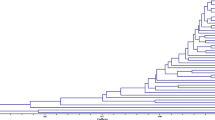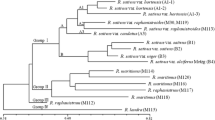Abstract
Isozyme and restriction fragment length polymorphisms (RFLPs) have been applied to studies of genetic relationships and germplasm management in cucumber (Cucumis sativus L.). However, isozymes identify relatively few polymorphisms, and RFLPs are technically complex, expensive, and not compatible for the high through-put required for rigorous assessment of this narrow-based germplasm. Since random amplified polymorphic DNA (RAPD) markers do not manifest such shortcomings, a study was conducted in cucumber to examine genetic relationships in diverse germplasm, assess the usefulness of RAPD markers in distinguishing elite accessions, and compare the relative effectiveness of RAPD markers to that of isozyme and RFLP markers. One hundred and eighteen C. sativus accessions were analyzed using variation at 71 RAPD loci (44 mapped and 27 unmapped). Genetic distances among accessions were estimated using the simple matching coefficient complement, and analyzed using multi-dimensional scaling. Each accession had a unique marker profile, indicating that RAPD analysis was useful in genotypic differentiation. Germplasm grouping patterns were consistent with individual accession origins, theoretical dispersal routes and discriminating morphological characters (i.e., sex expression and fruit length to diameter ratio). Although elite accessions were discriminated by RAPD profiling, their genetic distances were relatively small (between 0.01 and 0.58), indicating limited genetic diversity in this germplasm array. Assessment of a subset of the germplasm array using RAPDs resulted in genetic distance measurements more similar to published genetic distance estimates by RFLP markers (Spearman rank correlation, rs = 0.7–0.8) than estimates by isozyme markers (rs = 0.4). Data indicate that RAPD markers have utility for analysis of genetic diversity and germplasm management in cucumber.
Similar content being viewed by others
References
Brothwell, D. & P. Brothwell, 1969. Food in Antiquity: A Survey of the Diet of Early Peoples. Fredrick A. Praeger Publishers, New York, NY.
Dijkhuizen, A., W.C. Kennard, M.J. Havey & J.E. Staub, 1996. RFLP variation and genetic relationships in cultivated cucumber. Euphytica 90: 79–87.
Galun, E., 1961. Study of the inheritance of sex expression in the cucumber. The interaction of major gene with modifying genetic and non-genetic factors. Genetica 32: 134–163.
Gibbons, J.D., 1976. Nonparametric Methods for Quantitative Analysis. Holt, Rinehart and Winston, New York, NY.
Horejsi, T., 1998. Random amplified polymorphic DNA and sequence characterized amplified regions for studies of genetic diversity and downy mildew resistance in cucumber. Ph.D. Dissertation, University of Wisconsin, Madison, WI.
Horst, E.K. & R.L. Lower, 1978. Cucumis hardwickii: a source of germplasm for the cucumber breeder. Cucurbit Genet. Coop. Rpt. 1: 5.
Kennard, W.C., K. Poetter, A. Dijkhuizen, V. Meglic, J.E. Staub & M.J. Havey, 1994. Linkage among RFLP, RAPD, isozyme, disease-resistance, and morphological markers in narrow and wide crosses of cucumber. Theor. Appl. Genet. 89: 42–48.
Knerr, L.D., J.E. Staub, D.J. Holder & B.P. May, 1989. Genetic diversity in Cucumis sativus L. assessed by variation at 18 allozyme coding loci. Theor. Appl. Genet. 78: 119–128.
Kubicki, B., 1969. Investigations on sex determination in cucumber (Cucumis sativus L.). Genet. Pol. 10: 3–143.
Kruskal, J.B. & M. Wish, 1978. Multidimensional scaling. In Sage University Paper Series on Quantitative Applications in the Social Sciences. Sage Publ., Beverly Hills, CA.
Leppik, E.E., 1966. Searching gene centers of the genus Cucumis through host-parasite relationship. Euphytica 15: 323–328.
Lower, R.L. & M.D. Edwards, 1986. Cucumber breeding. In M.J. Basset (Ed.), Breeding Vegetable Crops, pp. 173–207. AVI Publishing. Westport, CI.
Lu, J., M.R. Knox, M.J. Ambrose, J.K.M. Brown & T.H.N. Ellis, 1996. Comparative analysis of genetic diversity in pea assessed by RFLP-and PCR-based methods. Theor. Appl. Genet. 93: 1103–1111.
Maniatis, T., E.F. Fritsch & J. Sambrook, 1982. Molecular Cloning: a Laboratory Manual. Cold Spring Harbor Laboratory Press, Cold Spring Harbor, NY.
McCreight, J.D. & J.E. Staub, 1993. Indo–US Cucumis germplasm expedition. HortScience 28: 467.
Meglic, V., F. Serquen & J.E. Staub, 1996. Genetic diversity in cucumber (Cucumis sativus L): I. A reevaluation of the U.S. germplasm collection. Genet. Res. Crop Evol. 43: 533–546.
Meglic, V. & J.E. Staub, 1996a. Inheritance and linkage relationships of isozyme and morphological loci in cucumber (Cucumis sativus L.). Theor. Appl. Genet. 92: 865–872.
Meglic, V. & J.E. Staub, 1996b. Genetic diversity in cucumber (Cucumis sativus L): II. An evaluation of selected cultivars released between 1846 and 1978. Genet. Res. Crop Evol. 43: 547–558.
Nagaoka, T. & Y. Ogihara, 1997. Applicability of inter-simple sequence repeat polymorphisms in wheat for use as DNA markers in comparison to RFLP and RAPD markers. Theor. Appl. Genet. 94: 597–602.
Pierce, L.W. & T.C. Wehner, 1990. Review of genes and linkage groups of cucumber. HortScience 25: 605–615.
Rafalski, J.A. & S.V. Tingey, 1993. Genetic diagnosis in plant breeding: RAPDs, microsatellites and machines. Trends Genet. 9: 275–280.
dos Santos, J.B., J. Nienhuis, P. Skroch, J. Tivang & M.K. Slocum. 1994. Comparison of RAPD and RFLP genetic markers in determining genetic similarity among Brassica oleracea L. genotypes. Theor. Appl. Genet. 87: 909–915.
Serquen, F.C., J. Bacher & J.E. Staub, 1997. Mapping and QTL analysis of horticultural traits in a narrow cross in cucumber (Cucumis sativus L.) using random-amplified polymorphic DNA markers. Mol. Breed. 3: 257–268.
Shifriss, O., 1961. Sex control in cucumber. J. Hered. 52: 5–12.
Sokal, R.R. & F.J. Rohlf, 1981. Biometry, 2nd ed. Freeman, San Francisco, CA.
Sokal, R.R. & P.H. Sneath, 1963. Principles of Numerical Taxonomy. Freeman, San Francisco, CA.
Spooner, D.M., J. Tivang, J. Nienhuis, J.T. Miller, D.S. Douches & A. Contreras-M., 1996. Comparison of four molecular markers in measuring relationships among the wild potato relatives Solanum section Etuberosum (subgenus Potato). Theor. Appl. Genet. 92: 532–540.
Staub, J.E. & V. Meglic, 1993. Molecular genetic markers and their legal relevance for cultigen discrimination: a case study in cucumber. HortTechnology 3: 291–300.
Staub, J.E., F. Serquen & M. Gupta, 1996a. Genetic markers, map construction, and their application in plant breeding. HortScience 31: 729–741.
Staub, J.E., A. Gabert & T.C. Wehner, 1996b. Plant variety protection: a consideration of genetic relationships. HortScience 31: 1086–1091.
Staub, J.E., J. Bacher & K. Poetter, 1996c. Sources of potential errors in the application of random amplified polymorphic DNAs in cucumber. HortScience 31: 262–266.
Staub, J.E., F. Serquen & J.D. McCreight, 1997a. Genetic diversity in cucumber (Cucumis sativus L): III. An evaluation of Indian germplasm. Genet. Res. Crop Evol. 44: 315–326.
Staub, J.E., J. Box, V. Meglic, T.F. Horejsi & J.D. McCreight, 1997b. Comparison of isozyme and random amplified polymorphic DNA data for determining intraspecific variation in Cucumis. Genet. Res. Crop Evol. 44: 257–269.
Steel, R. & J. H. Torrie, 1980. Principles and procedures of statistics. 2nd ed. McGraw-Hill, New York, NY.
Sturtevant, E.L., 1919. Notes on edible plants. In: Hedrick, U. P. (Ed.) Report of the N.Y. Ag. Ex. Stat. for the year 1919m, Vol. 2, part II. Albany, NY.
Tatlioglu, T., 1993. Cucumber Cucumis sativus L. In: G. Kalloo and B. O. Bergh (Eds), Genetic Improvement of Vegetable Crops, pp. 197–234. Pergamon Press, Ltd., Tarrytown, NY.
Thormann, C.E., M.E. Ferreira, L.E.A. Camargo, J.G. Tivang & T.C. Osborn, 1994. Comparison of RFLP and RAPD markers for estimating genetic relationships within and among cruciferous species. Theor. Appl. Genet. 88: 973–980.
Waugh, R. & W. Powell, 1992. Using RAPD markers for crop improvement. Trends Biotech. 10: 186–191.
Whitaker, T.W. & G.N. Davis, 1962. Cucurbits: Botany, Cultivation, and Utilization. Interscience Publishers, New York, NY.
Wilkinson, L., 1989. SYSTAT: the System for Statistics. SYSTAT Inc., Evanston, IL.
Williams, J.G.K., A.R. Kubelik, K.J. Livak, J.A. Rafalski & S.V. Tingey, 1990. DNA polymorphisms amplified by arbitrary primers are useful as genetic markers. Nucleic Acids Res. 18: 6531–6535.
Author information
Authors and Affiliations
Rights and permissions
About this article
Cite this article
Horejsi, T., Staub, J.E. Genetic variation in cucumber (Cucumis sativus L.) as assessed by random amplified polymorphic DNA1. Genetic Resources and Crop Evolution 46, 337–350 (1999). https://doi.org/10.1023/A:1008650509966
Issue Date:
DOI: https://doi.org/10.1023/A:1008650509966




